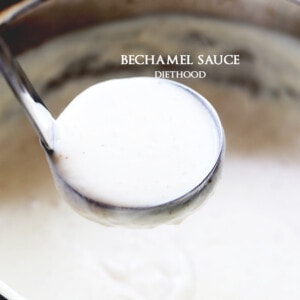This post may contain affiliate links. Please read our disclosure policy.
Béchamel sauce is a classic and creamy French white sauce made from butter, flour, and milk. Everyone needs a good béchamel sauce recipe, and this one is super easy!
Use this béchamel sauce as-is, layered into lasagna Bolognese, or as a base for more sauces, like homemade alfredo.

I feel like everyone should know how to make béchamel sauce. Despite the fancy-sounding French name, it’s super quick and easy! You may have already made something like it without knowing. If you’ve ever whisked flour and butter into a roux to thicken soup or turn pan drippings into gravy, you’re already two-thirds of the way to béchamel sauce! I’ll show you how to make a roux and turn it into a silky white sauce that’s free of lumps and ready to use in all your favorite recipes, including homemade mac and cheese!
Why I Love This Easy Béchamel Sauce
- Versatile. Béchamel sauce is one of the most versatile recipes you can have in the kitchen. Use it in pasta, lasagna, casseroles, and as a base for even more sauces.
- Basic ingredients. There are really only three of them (flour, butter, and milk), plus any seasonings (nutmeg is the classic choice). As one of the French mother sauces, béchamel is meant to be basic in the best possible way.
- Foolproof. The key to a smooth white sauce is patience, but luckily, this recipe doesn’t require too much of your time. It’s a very easy process. Cook the roux, slowly add the milk, and then simmer the sauce to thicken. Tada!

What Is Béchamel Sauce?
Béchamel is made by cooking butter and flour together in a roux, then adding milk to create a rich, silky white sauce. It’s one of the five mother sauces in cooking (another one is hollandaise). You can use béchamel sauce on its own or as a base for other sauces and recipes. More on this below!
Ingredients You’ll Need
Béchamel sauce is made of a handful of simple ingredients, which I’ll cover along with some notes here. You’ll find a printable ingredients list with the full recipe details in the recipe card after the post.
- Butter – I like to use unsalted butter and season the sauce to taste. Salted butter also works, just remember to go easy when adding salt later on.
- Flour – All-purpose flour is best. Avoid self-rising flour when making a white sauce, since self-rising flour contains ingredients like baking powder which can affect the flavor.
- Milk – Whole milk or your choice of milk, warmed up.
- Nutmeg – In addition to salt and pepper, classic béchamel is seasoned with nutmeg. If you don’t have nutmeg to grate fresh, you can substitute it with ground. I always find that I need to use more in this case (about 1 full teaspoon of pre-ground nutmeg per ¼ teaspoon of grated). You can also leave it out if you’d prefer.

How to Make Béchamel Sauce
The basic formula for béchamel sauce is equal parts butter and flour, and you can adjust the amount of milk depending on how thick or thin you’d like your sauce to be. This recipe makes a perfect medium-thickness béchamel. Here’s how:
- Make a roux. Start by melting butter in a saucepan, and whisk in the flour. Keep whisking as the roux cooks off and browns.
- Add milk and cook. After a few minutes, slowly stream in the hot milk. Continue stirring and let that come to a low boil. Simmer the sauce until it thickens.
- Season to taste. Season the sauce off the heat with salt, pepper, and nutmeg. Your béchamel sauce is ready to use!
Why Should I Heat the Milk for Béchamel?
Technically, you can make béchamel by adding cold milk to the roux. However, hot milk blends better and results in a smoother sauce that thickens more easily. You can warm the milk either in a separate pot on the stovetop or in the microwave.

Tips to Remember
- Get the right ratio. The perfect roux consists of equal parts fat (butter) and flour.
- Add the flour all at once. Whisk in the flour by hand and keep whisking until there are no lumps left over, for a smooth, silky sauce.
- Take it slow. Overheating can burn the roux. Melt the butter over medium-low heat, and only raise the temperature once the milk is whisked into the roux. Be careful not to boil the sauce for too long, either. Just enough so that it thickens without curdling or splitting.
Frequently Asked Questions
Yes, it’s possible to overcook béchamel sauce, so work slowly over steady heat. Overheating the sauce can make it curdle.
No. When cooking the roux, the butter/flour should start to smell nutty after 5-8 minutes. If you taste it, you shouldn’t pick up any raw flour flavors. If the roux still tastes a bit floury, cook it off more to prevent the béchamel sauce from tasting like flour.
Make sure that you boil the sauce for long enough so that it can thicken. If it still looks runny, prepare a small amount of fresh roux in a separate pan, and then whisk this into the sauce. Boil again for a few minutes and it should thicken up nicely.

Ways to Use Béchamel Sauce
Once you’ve mastered the art of béchamel sauce, there are SO MANY dishes where you can use it, whether you layer it into a butternut squash lasagna, sausage and eggplant casserole, or cheesy cauliflower gratin. Béchamel is also the “mother” sauce for more sauces, including:
- Mornay – Béchamel with shredded cheese, like Gruyère cheese and parmesan (a bit like alfredo sauce, but without heavy cream).
- Cheddar Sauce – Béchamel with whole milk and cheddar cheese (used as the base for mac and cheese).
- Cream Sauce – Add heavy cream, similar to the sauce in creamed spinach.
- Soubise – Béchamel blended with caramelized onions.
Storage
- Refrigerate. Store the béchamel sauce airtight in the fridge for up to 3 days. When storing béchamel sauce, I like to press a piece of plastic wrap directly against the surface of the sauce before closing the container, to prevent skin from forming.
- Reheat. If you’d like to warm up your sauce, reheat it over gentle heat on the stovetop until it’s warmed through. You can also reheat it in the microwave in increments, stirring in between.
- Freeze. You can also freeze the sauce, though you may notice a slight change in texture once it’s thawed. Freeze the béchamel airtight for up to 1 month and thaw it in the fridge when you’re ready to use it.
More Homemade Sauces
Pin this now to find it later
Pin It
Béchamel Sauce
Ingredients
- 4 tablespoons butter
- ¼ cup all-purpose flour
- 3 cups hot milk
- 1 teaspoon salt
- fresh ground black pepper, to taste
- ¼ teaspoon grated nutmeg, optional
Instructions
- Make a roux. Begin by melting the butter over medium-low heat. Once melted, whisk in the flour; whisk until all lumps have disappeared and the mixture turns a light brown color, about 5 minutes.
- Add milk. Pour in the hot milk, a little bit at a time, and continue to whisk until smooth. Bring the sauce to a boil and cook for 8 minutes, stirring constantly, or until sauce is thickened.
- Season and serve. Remove from the heat and stir in salt, pepper, and nutmeg. Set aside until ready to use.
Nutrition
Nutritional info is an estimate and provided as courtesy. Values may vary according to the ingredients and tools used. Please use your preferred nutritional calculator for more detailed info.










Great: i got it right the first time following it exactly. I used almond milk. Thanks
That’s great to hear! I’m very glad you enjoyed it! Thank YOU! 🙂
Have tried this with Almond milk?
No, I have not tried making this with nut milk.
Has anyone used nut milk on this yet and does it work?
Question;
Can I prepare the sauce and use it another day, or I have to use it right away?
Thank you
Hi Dalila! You can make it up to a day ahead of time, but make sure to quickly cool it right after cooking it… you can quickly cool it over an ice bath. Cover it with plastic wrap to prevent a skin forming, and refrigerate right away.